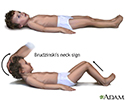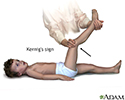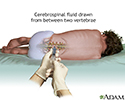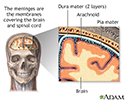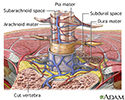Meningitis
Meningitis - bacterial; Meningitis - viral; Meningitis - fungal; Meningitis - vaccine
Meningitis is an infection of the membranes covering the brain and spinal cord. This covering is called the meninges.
Causes
The most common causes of meningitis are viral infections. These infections usually get better without treatment. But, bacterial meningitis infections are very serious. They may result in death or brain damage, even if treated.
Meningitis may also be caused by:
- Chemical irritation
- Drug allergies
- Fungi
- Parasites
- Tumors
Many types of viruses can cause meningitis:
- Enteroviruses: These are viruses that also can cause intestinal illness.
-
Herpes viruses: These are the same viruses that can cause
cold sores
and
genital herpes
. However, people with cold sores or genital herpes do not have a higher chance of developing herpes meningitis.
Cold sores
Oral herpes is an infection of the lips, mouth, or gums due to the herpes simplex virus. It causes small, painful blisters commonly called cold sore...
 ImageRead Article Now Book Mark Article
ImageRead Article Now Book Mark ArticleGenital herpes
Genital herpes is a sexually transmitted infection. It is caused by the herpes simplex virus. This article focuses on HSV type 2 infection.
 ImageRead Article Now Book Mark Article
ImageRead Article Now Book Mark Article - Mumps and HIV viruses can cause aseptic meningitis.
-
West Nile virus
: This virus is spread by mosquito bites and has become a cause of viral meningitis in most of the United States.
West Nile virus
West Nile virus is a disease spread by mosquitoes. The condition ranges from mild to severe.
 ImageRead Article Now Book Mark Article
ImageRead Article Now Book Mark Article
Symptoms
Viral meningitis occurs more often than bacterial meningitis, and is milder. It usually occurs in the late summer and early fall. It most often affects children and adults under age 30. Symptoms may include:
- Headache
- Sensitivity to light ( photophobia )
- Slight fever
- Fatigue
Bacterial meningitis is an emergency. You will need immediate treatment in a hospital. Symptoms usually come on quickly, and may include:
- Fever and chills, especially in newborns and children
-
Mental status changes
Mental status changes
Confusion is the inability to think as clearly or quickly as you normally do. You may feel disoriented and have difficulty paying attention, remembe...
 ImageRead Article Now Book Mark Article
ImageRead Article Now Book Mark Article - Nausea and vomiting
- Sensitivity to light
- Severe headache
- Stiff neck
Other symptoms that can occur with this disease:
-
Agitation
Agitation
Agitation is an unpleasant state of extreme arousal. An agitated person may feel stirred up, excited, tense, confused, or irritable.
 ImageRead Article Now Book Mark Article
ImageRead Article Now Book Mark Article -
Bulging fontanelles
in babies
Bulging fontanelles
A bulging fontanelle is an outward curving of an infant's soft spot (fontanelle).
 ImageRead Article Now Book Mark Article
ImageRead Article Now Book Mark Article -
Decreased alertness
Decreased alertness
Decreased alertness is a state of reduced awareness. A coma is a state of decreased alertness from which a person cannot be awakened. A long-term co...
Read Article Now Book Mark Article - Poor feeding or irritability in children
- Rapid breathing
-
Unusual posture, with the head and neck arched backward (
opisthotonos
)
Opisthotonos
Opisthotonos is a condition in which a person holds their body in an abnormal position. The person is usually rigid and arches their back, with thei...
Read Article Now Book Mark Article
You cannot tell if you have bacterial or viral meningitis by how you feel. Your health care provider must find out the cause. Go to the hospital emergency department right away if you think you have symptoms of meningitis.
Exams and Tests
Your provider will examine you. This may show:
- Fast heart rate
- Fever
- Mental status changes
- Stiff neck
If the provider thinks you have meningitis, a lumbar puncture ( spinal tap ) should be done to remove a sample of spinal fluid (cerebrospinal fluid, or CSF) for testing.
Spinal tap
Cerebrospinal fluid (CSF) collection is a test to look at the fluid that surrounds the brain and spinal cord. CSF acts as a cushion, protecting the b...

Other tests that may be done include:
-
Blood culture
Blood culture
A blood culture is a laboratory test to check for bacteria or other germs in a blood sample.
Read Article Now Book Mark Article -
Chest x-ray
Chest x-ray
A chest x-ray is an x-ray of the chest, lungs, heart, large arteries, ribs, and diaphragm.
 ImageRead Article Now Book Mark Article
ImageRead Article Now Book Mark Article -
CT scan of the head
CT scan of the head
A head computed tomography (CT) scan uses many x-rays to create pictures of the head, including the skull, brain, eye sockets, and sinuses.
 ImageRead Article Now Book Mark Article
ImageRead Article Now Book Mark Article
Treatment
Antibiotics are used to treat bacterial meningitis. Antibiotics do not treat viral meningitis. But antiviral medicine may be given to those with herpes meningitis.
Other treatments will include:
- Fluids through a vein (IV)
-
Medicines to treat symptoms, such as brain swelling,
shock
, and
seizures
Shock
Shock is a life-threatening condition that occurs when the body is not getting enough blood flow. Lack of blood flow means that the cells and organs...
 ImageRead Article Now Book Mark Article
ImageRead Article Now Book Mark ArticleSeizures
A seizure is the physical findings or changes in behavior that occur after an episode of abnormal electrical activity in the brain. The term "seizure...
 ImageRead Article Now Book Mark Article
ImageRead Article Now Book Mark Article
Outlook (Prognosis)
Early diagnosis and treatment of bacterial meningitis is essential to prevent permanent neurological damage. Viral meningitis is usually not serious, and symptoms should disappear within 2 weeks with no lasting complications.
Possible Complications
Without prompt treatment, meningitis may result in the following:
- Brain damage
-
Buildup of fluid between the skull and brain (
subdural effusion
)
Subdural effusion
A subdural effusion is a collection of cerebrospinal fluid (CSF) trapped between the surface of the brain and the outer lining of the brain (the dura...
Read Article Now Book Mark Article -
Hearing loss
Hearing loss
Hearing loss is being partly or totally unable to hear sound in one or both ears.
 ImageRead Article Now Book Mark Article
ImageRead Article Now Book Mark Article -
Buildup of fluid inside the skull that leads to brain swelling (
hydrocephalus
)
Hydrocephalus
Hydrocephalus is a buildup of fluid inside the skull that leads to brain swelling. Hydrocephalus means "water on the brain. "
 ImageRead Article Now Book Mark Article
ImageRead Article Now Book Mark Article - Seizures
- Death
When to Contact a Medical Professional
If you think that you or your child has symptoms of meningitis, get emergency medical help immediately. Early treatment is key to a good outcome.
Prevention
Certain vaccines can help prevent some types of bacterial meningitis:
-
Haemophilus vaccine (
HiB vaccine
) given to children helps
HiB vaccine
All content below is taken in its entirety from the CDC Hib (Haemophilus Influenzae Type b) Vaccine Information Statement (VIS): www. cdc. gov/vaccin...
 ImageRead Article Now Book Mark Article
ImageRead Article Now Book Mark Article -
Pneumococcal vaccine is given to
children
and
adults
Children
All content below is taken in its entirety from the CDC Information Statement (VIS): www. cdc. gov/vaccines/hcp/vis/vis-statements/pcv13. htmlCDC rev...
 ImageRead Article Now Book Mark Article
ImageRead Article Now Book Mark ArticleAdults
All content below is taken in its entirety from the CDC Pneumococcal Polysaccharide Vaccine Information Statement (VIS): www. cdc. gov/vaccines/hcp/v...
 ImageRead Article Now Book Mark Article
ImageRead Article Now Book Mark Article -
Meningococcal vaccines is given to
children and adults
; some communities hold vaccination campaigns after an outbreak of meningococcal meningitis.
Children and adults
All content below is taken in its entirety from the CDC Meningococcal ACWY Vaccines - MenACWY and MPSV4 Vaccine Information Statement (VIS): www. cd...
Read Article Now Book Mark Article
Household members and others in close contact with people who have meningococcal meningitis should receive antibiotics to prevent becoming infected.
References
Nath A. Meningitis: bacterial, viral, and other. In: Goldman L, Schafer AI, eds. Goldman-Cecil Medicine . 25th ed. Philadelphia, PA: Elsevier Saunders; 2016:chap 412.
Tunkel AR, Van de Beek D, Scheld WM. Acute meningitis. In: Bennett JE, Dolin R, Blaser MJ, eds. Mandell, Douglas, and Bennett's Principles and Practice of Infectious Diseases, Updated Edition . 8th ed. Philadelphia, PA: Elsevier Saunders; 2015:chap 89.
-
Brudzinski's sign of meningitis - illustration
One of the physically demonstrable symptoms of meningitis is Brudzinski's sign. Severe neck stiffness causes a patient's hips and knees to flex when the neck is flexed.
Brudzinski's sign of meningitis
illustration
-
Kernig's sign of meningitis - illustration
One of the physically demonstrable symptoms of meningitis is Kernig's sign. Severe stiffness of the hamstrings causes an inability to straighten the leg when the hip is flexed to 90 degrees.
Kernig's sign of meningitis
illustration
-
Lumbar puncture (spinal tap) - illustration
A lumbar puncture, or spinal tap, is a procedure to collect cerebrospinal fluid to check for the presence of disease or injury. A spinal needle is inserted, usually between the 3rd and 4th lumbar vertebrae in the lower spine. Once the needle is properly positioned in the subarachnoid space (the space between the spinal cord and its covering, the meninges), pressures can be measured and fluid can be collected for testing.
Lumbar puncture (spinal tap)
illustration
-
Meninges of the brain - illustration
The organs of the central nervous system (brain and spinal cord) are covered by connective tissue layers collectively called the meninges. Consisting of the pia mater (closest to the CNS structures), the arachnoid and the dura mater (farthest from the CNS), the meninges also support blood vessels and contain cerebrospinal fluid. These are the structures involved in meningitis, an inflammation of the meninges, which, if severe, may become encephalitis, an inflammation of the brain.
Meninges of the brain
illustration
-
Meninges of the spine - illustration
The organs of the central nervous system (brain and spinal cord) are covered by 3 connective tissue layers collectively called the meninges. Consisting of the pia mater (closest to the CNS structures), the arachnoid and the dura mater (farthest from the CNS), the meninges also support blood vessels and contain cerebrospinal fluid. These are the structures involved in meningitis, an inflammation of the meninges, which, if severe, may become encephalitis, an inflammation of the brain.
Meninges of the spine
illustration
-
Haemophilus influenza organism - illustration
This is a Gram stain of spinal fluid from a person with meningitis. The rod-like organisms seen in the fluid are Haemophilus influenza, one of the most common causes of childhood meningitis (prior to the widespread use of the H influenza vaccine). The large red-colored objects are cells in the spinal fluid. A vaccine to prevent infection by Haemophilus influenza (type B) is available as one of the routine childhood immunizations (Hib), typically given at 2, 4 and 12 months.
Haemophilus influenza organism
illustration
-
Brudzinski's sign of meningitis - illustration
One of the physically demonstrable symptoms of meningitis is Brudzinski's sign. Severe neck stiffness causes a patient's hips and knees to flex when the neck is flexed.
Brudzinski's sign of meningitis
illustration
-
Kernig's sign of meningitis - illustration
One of the physically demonstrable symptoms of meningitis is Kernig's sign. Severe stiffness of the hamstrings causes an inability to straighten the leg when the hip is flexed to 90 degrees.
Kernig's sign of meningitis
illustration
-
Lumbar puncture (spinal tap) - illustration
A lumbar puncture, or spinal tap, is a procedure to collect cerebrospinal fluid to check for the presence of disease or injury. A spinal needle is inserted, usually between the 3rd and 4th lumbar vertebrae in the lower spine. Once the needle is properly positioned in the subarachnoid space (the space between the spinal cord and its covering, the meninges), pressures can be measured and fluid can be collected for testing.
Lumbar puncture (spinal tap)
illustration
-
Meninges of the brain - illustration
The organs of the central nervous system (brain and spinal cord) are covered by connective tissue layers collectively called the meninges. Consisting of the pia mater (closest to the CNS structures), the arachnoid and the dura mater (farthest from the CNS), the meninges also support blood vessels and contain cerebrospinal fluid. These are the structures involved in meningitis, an inflammation of the meninges, which, if severe, may become encephalitis, an inflammation of the brain.
Meninges of the brain
illustration
-
Meninges of the spine - illustration
The organs of the central nervous system (brain and spinal cord) are covered by 3 connective tissue layers collectively called the meninges. Consisting of the pia mater (closest to the CNS structures), the arachnoid and the dura mater (farthest from the CNS), the meninges also support blood vessels and contain cerebrospinal fluid. These are the structures involved in meningitis, an inflammation of the meninges, which, if severe, may become encephalitis, an inflammation of the brain.
Meninges of the spine
illustration
-
Haemophilus influenza organism - illustration
This is a Gram stain of spinal fluid from a person with meningitis. The rod-like organisms seen in the fluid are Haemophilus influenza, one of the most common causes of childhood meningitis (prior to the widespread use of the H influenza vaccine). The large red-colored objects are cells in the spinal fluid. A vaccine to prevent infection by Haemophilus influenza (type B) is available as one of the routine childhood immunizations (Hib), typically given at 2, 4 and 12 months.
Haemophilus influenza organism
illustration
-
Meningitis
(Alt. Medicine)
Review Date: 11/27/2016
Reviewed By: Arnold Lentnek, MD, Infectious Diseases Medical Practice of NY and Clinical Research Centers of CT. Review provided by VeriMed Healthcare Network. Also reviewed by David Zieve, MD, MHA, Medical Director, Brenda Conaway, Editorial Director, and the A.D.A.M. Editorial team.


